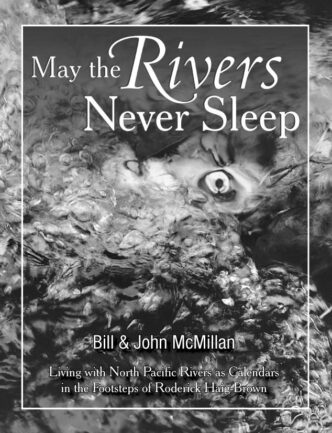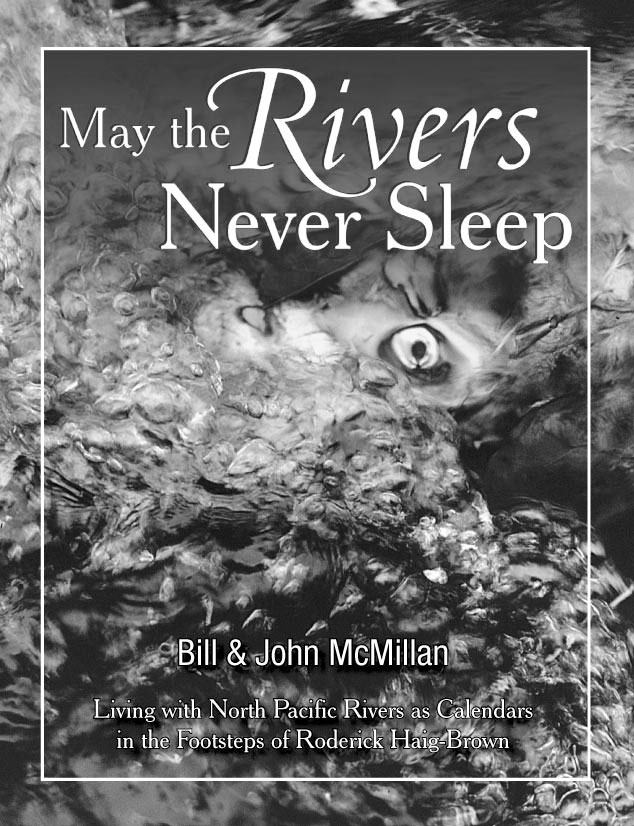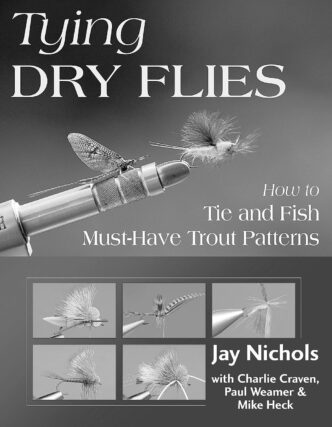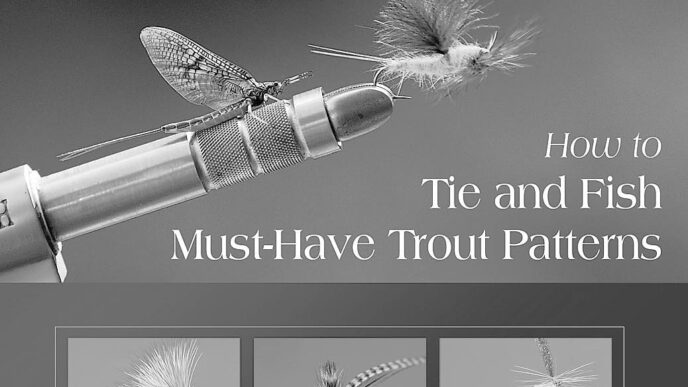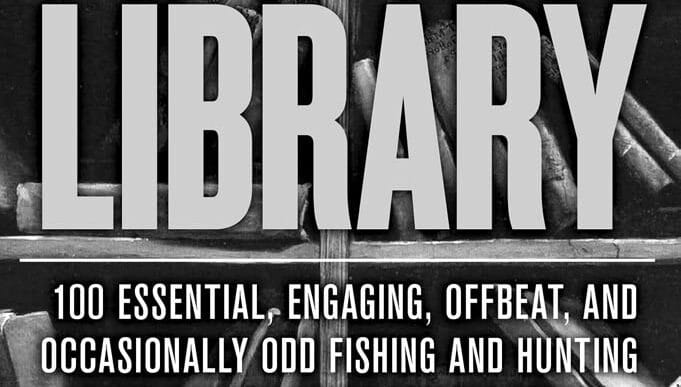May the Rivers Never Sleep
By Bill McMillan and John McMillan. Published by Frank Amato Publications, 2012; $49.95 hardbound.
In 1946, Roderick Haig-Brown, an Englishman who had moved to rural Vancouver Island in British Columbia to write and pursue a more rewarding life, published his fourth book, A River Never Sleeps, a graceful collection of observations and reminiscences, both angling and personal, that followed the months of the year on the rivers near his home. Haig-Brown has become something of an angling saint to steelheaders, and A River Never Sleeps, if not the angling equivalent of the Confessions of St. Augustine, is at least a hymnal to which we refer when the spirit needs freshening, when we need to be reminded of what’s to be gained by intimate knowledge of a river and of what, on reflection, we’ve lost.
Bill McMillan, a contemporary steelhead angler and writer from Washington who is responsible as much as anyone for the floating-line steelhead tactics practiced across the Northwest, first encountered Haig-Brown’s writing as a teenager in the late 1960s. McMillan has reread HaigBrown frequently over the past 40 years — during which time he raised a family in a four-room cabin on the Washougal River and retreated, after a divorce, to seven years in the wilderness of successively more remote river homes. Like Haig-Brown, McMillan was inspired to become as much an observer, naturalist, and conservationist as an angler. In his new book, May the Rivers Never Sleep, cowritten by Bill and his son John, an ecologist who shares his father’s passions, he tells us that he now spends more time with a snorkel than with a fly rod. “Angling at its best provides an emotional thrill of pursuit, but underwater experiences have been more magical for what is revealed.” Those of us who fish, as well as those who look for larger meaning in rivers, are richer for that shift and for that collaboration.
May the Rivers Never Sleep is simultaneously an explicit homage to Haig-Brown and a well-informed commentary on the state of our anadromous fisheries. It’s both scientific and spiritual. Like A River Never Sleeps, it looks at the life of Northwest angling watersheds through the prism of the changing months and divides its chapters accordingly, from January to December. But something more than the mere months of the year are at its heart. Rather, the McMillans’ focus is on the notion of a river calendar, a recurrent cycle of events and conditions that create and support our salmon and steelhead populations. The authors examine the life cycles of those fish, discuss the observable changes, both historical and contemporary, in the calendars of many Northwest rivers, speculate intelligently on their causes, describe the mixed dismay and hope that those changes presage, and argue persuasively for the power of nature to restore wild fish populations and the associated lives they support.
The authors concentrate mostly on the Pacific-flowing rivers of our Northwest, but they devote an entire chapter — October — to discussing those in Russia’s largely undeveloped Kamchatka Peninsula. For the McMillans, the “fabric” of Kamchatka’s anadromous fish population — a nice metaphor for describing the interwovenness of rivers and species — reveals what the Northwest’s own fabric must have been like before European settlement changed it: “a place where the layers of human uses that obscure the desire to understand are reduced, and where the scientific quest for essential truths is less inhibited by volumes of accumulated misinformation drawn from tattered resources.”
One of the continuing themes of the book is the astonishing diversity among what many still speak about as “runs” of fish. To say, for example, that there’s a fall run on a given river is to overlook how different, genetically and even morphologically, the chinook or steelhead or coho in one spawning tributary of that river, or in specific sections of that tributary, might be from those in another tributary or section. Local ecologies, defined by characteristics such as different gradients, bottom composition, and sediment loads, often support and nurture their own distinctive populations. By being slightly different, by being able to prosper in different conditions, those populations contribute significantly to the viability of the broader population and of the species as a whole.
The McMillans also provide an interesting discussion of interbreeding between resident rainbows and steelhead and suggest that “if research continues to find that resident males are . . . important to the productivity and diversity of steelhead . . . then a fish can’t be judged solely by size. It implies that all sizes, behaviors, and life histories are the rainbow/steelhead strategy for effective perpetuation in variable environments.”
Haig-Brown’s 1946 A River Never Sleeps was published in standard 6-by-8-inch book format and sparsely illustrated with Louis Darling’s graceful black-and-white drawings, so the detailed images that a reader formed of what Haig-Brown’s Campbell and Nimpkish Rivers looked like depended on a reader’s imagination. Sometimes that’s better than any photo. But this is 2012, and May the Rivers Never Sleep has been produced in a large-format, 9-by-12-inch volume, extensively illustrated with the McMillans’ excellent color and black-and-white photography. There are enough images of steelhead, cutthroats, rainbows, Dolly Vardens, and bull trout, coho, chinook, chum, pink, and sockeye salmon, some framed against a fly rod and reel, to satisfy the most ardent devotee of fish porn. But there are even more riverscapes, of streams up and down the North Pacific, along with stunning underwater photography of fish in various life stages. I’ll go back to the book frequently for the photography alone. But I also suspect that rereadings will reveal, as when I reread Haig-Brown, new levels of understanding of a subject that’s at the heart and soul of the Northwest I love.
Larry Kenney
Stalking Trophy Brown Trout: A Fly-Fisher’s Guide to Catching the Biggest Trout of Your Life
By John Holt. Published by Lyons Press, 2012; $24.95 softbound.
Stalking Trophy Brown Trout is a meat-and-potatoes book: no frills, nothing fancy, trendy, or even new. In fact, it is pretty old-school in every regard. Many times throughout the book you get the feeling the pages were lifted from a 1970s Field & Stream.
A number of the suggested patterns will more likely be found in a Midwestern gas station than a modern fly shop. RatFaced McDougals, Gray Ghosts, BlackNosed Dace, Joe’s Hoppers, and Yellow Humpies make the cut. The techniques are likewise dated, but tried and true. Some of the cutting-edge flies, gear, and techniques being promoted today will likely be forgotten in three years, while Holt’s teachings have already proven their staying power.
For experienced anglers, the book might be interesting, but for new or intermediate fly fishers looking to chase brown trout, I can’t think of many resources that include so much useful and time-tested information between two covers.
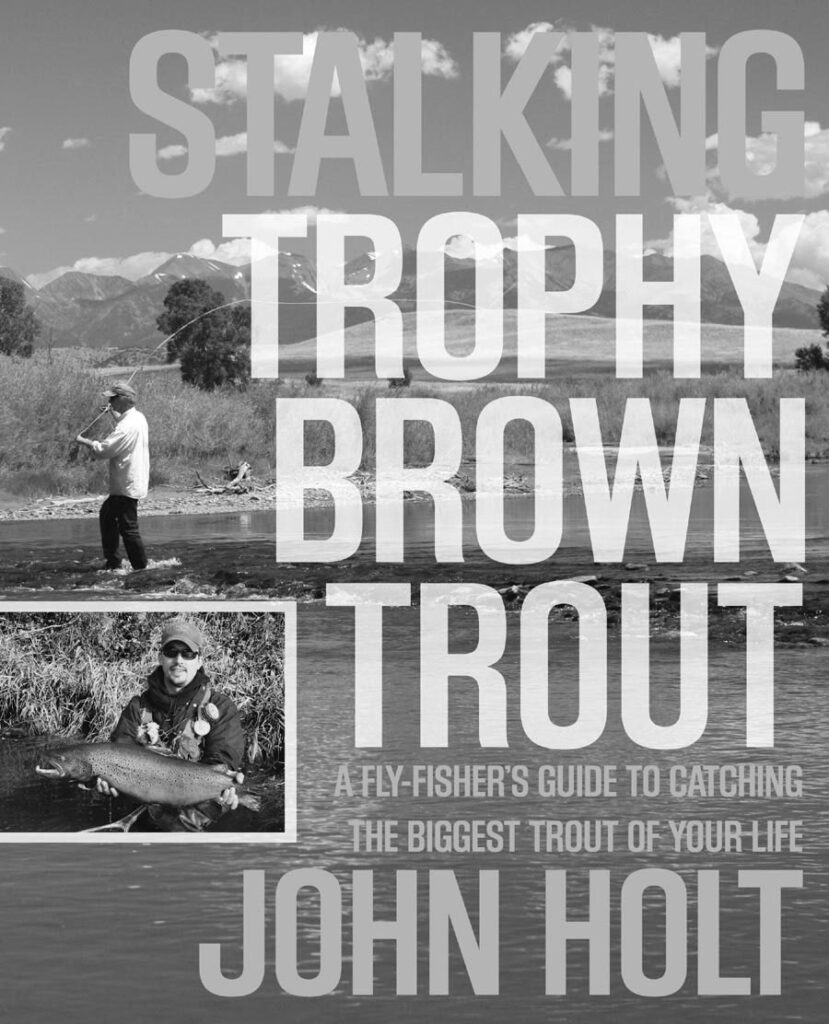
Holt’s writing is gruff and gritty, and sometimes his choice of words leaves you wondering exactly what he was trying to say. This may sound like a criticism, but it isn’t meant to be — it is simply how he writes and how he describes himself. Again, much about this book is a throwback to the “Me and Joe” era of writing, when every how-to was prefaced by an angling anecdote, which isn’t to say it is in any way bad.
In the “Me and Joe” era, though, entomology was a five-syllable afterthought, rather than the core of angling strategy. Holt spends four or five pages describing how damselfly nymphs swim to the surface and repeatedly bang against the meniscus before they can “break through the surface film and get into the air to dry off.” He even has a fly (Bigg’s Special) and techniques to imitate this emergence behavior. Unfortunately, none of this actually happens. Damselfly nymphs crawl up reeds or onto shoreline structure and commence emergence well out of range of trout. Oh well.
Of all the chapters, the one titled “Reading the Water” is the best. With expressive photos, Holt describes the intricacies of seams, cuts, and edges and how to cover them effectively with a fly. Few angling authors expound on the way to exploit depressions, buckets, and corners better than he does. It shows, to me at least, that this writer is the real deal and has learned well from the school of hard knocks.
Ralph Cutter
The New Scientific Angling: Trout and Ultraviolet Vision
By Reed Curry. Published by Buckram Publishing, 2009; $27.95 softbound.
I bought this book within weeks of its publication back in 2009. The spine is thoroughly broken, and my scribbles and dog ears abound throughout my copy. I have obviously found it useful and intriguing, but never considered doing a book review, because it is such a geeky subject. I mean, how many people out there could actually care about trout seeing ultraviolet? As it turns out, the fly-fishing industry is betting on the idea that lots of folks are going to buy into the importance of UV reflectance in flies, materials, and streamside clothing. Wapsi, Hareline, and Spirit River are among the big-name companies pumping their UV-enhanced products into the market. Spirit River has an excellent and quite honest evaluation of UV products. Check out their Web site at http://spiritriver.net/uv.
The first 20 percent of this book describes how ultraviolet light works, how animals use it (turns out humans are one of the few creatures that can’t see UV), and how we can apply it to our advantage. The book then delves into how trout see, how they perceive, and how they react.
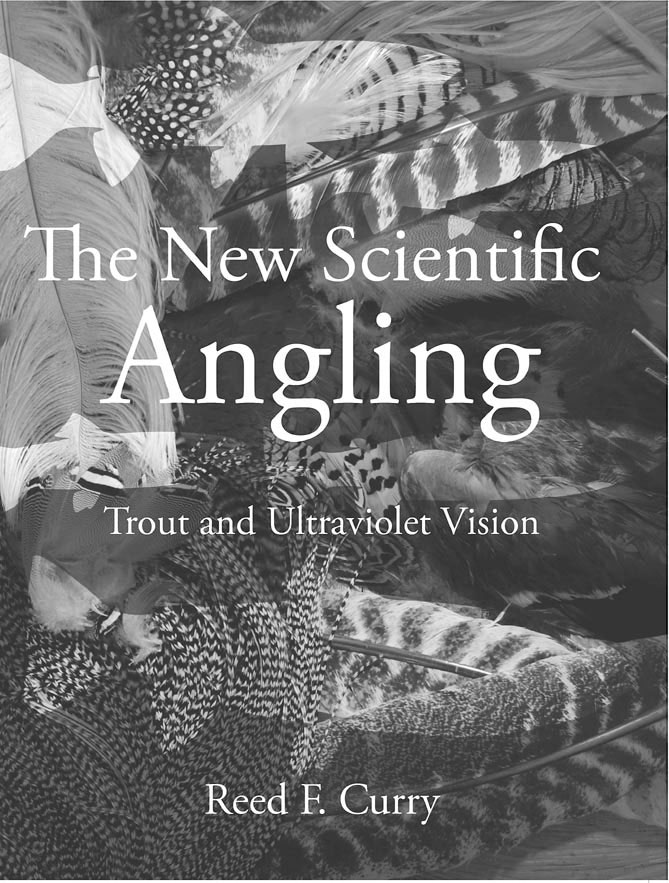
The part of the book to which I have returned over and over again are pages 47 through 128. The author, with extremely cool (and expensive) UV photo gear, has photographed dozens, if not hundreds, of items used in fly fishing. Flies, feathers,
fur, thread, and even clothing and fly lines are displayed in their full glory reflecting UV light.
My favorite photos, of course, are the insects. These are dead, dried bugs skewered with pins, then photographed in a studio, so I know they are quite different from what a trout sees, but they are the best I have found anywhere. Until someone does this work with a spectrophotometer on living insects, it is the best any of us are likely to see. Since we can’t see UV, if you are going to tie flies intelligently with the new UV-enhanced products, buy this book!
It is a book, by the way, that is apparently self-published without an editor. I could hold its feet to the fire for a number of technical and aesthetic reasons — including the title, The New Scientific Angling (?) — but the book is much more than grammar, layout, and flow. This is a content-driven work that will thrill the geeks among us and bore the rest. You probably know which you are.
Ralph Cutter
Profound River
By John Gubbins. Published by Sweetwater Books, 2012; $15.99 softbound.
An eminent historian of medieval England once was delivering a lecture on the dynastic succession of the Plantagenets when an undergraduate interrupted him. “What I really want to know,” the student said, “is what everyday life was like for people during the Middle Ages.” “Have you seen Monty Python and the Holy Grail?” the professor asked. “Well, it was just like that.”
He was referring to the movie’s background of pervasive squalor, ignorance, violence, cruelty, and poverty, not so much to chivalric quests for “a shrubbery — a nice one!” Life was tough back then, even though they presumably rode real horses, instead of prancing around with coconutshell clip-clops.
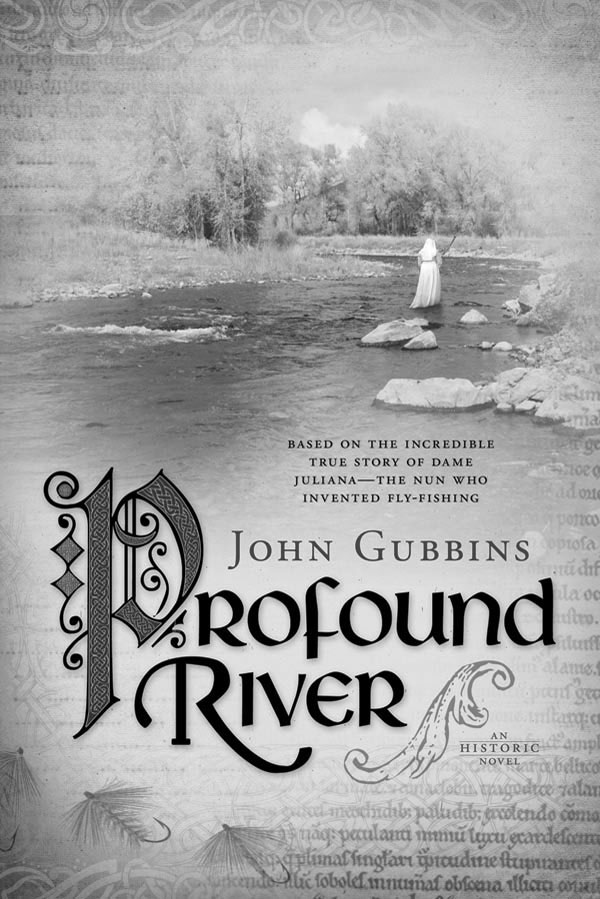
The travails of dynastic succession and the everyday life of real people in late medieval England come together in this historical novel about Dame Juliana Berners. A Treatyse of Fysshynge with an Angle was the first book on fly fishing published in any language, appearing as part of The Boke of St. Albans, a compilation of activities suitable for a gentleman to pursue, in 1496. It is usually said, condescendingly, to be “attributed” to Dame Juliana, a nobly born Englishwoman who became a Benedictine nun and prioress of St. Mary Sopwell Priory in St. Albans. But who was Dame Juliana Berners, and did a woman — a nun, at that — actually write the first book on fly fishing?
John Gubbins answers those questions — twice — in Profound River. In an imaginative reconstruction of the inner life of Dame Juliana during a crux in her career as prioress of Sopwell, intercut with flashbacks in memory to her early life, he dramatizes the ways in which, forced by the vicissitudes afflicting a family caught in the machinations that replaced Richard II with Henry IV on the English throne, Juliana Berners finds both refuge and a pragmatic approach to the world in a life of contemplation and engagement with everyday things. Raised in the noble arts of hawking and hunting (she develops a reputation as a falcon whisperer), she seeks solace in the more contemplative sport of fishing, but also in the structure of the Benedictine celebration of the “hours” of the day, in writing, and in bringing aid and compassion to those whose lives are subject to both the arbitrary power of those who rule them and the depredations of plague, war, and all the other miseries that could afflict the English in a time of more or less constant political upheaval.
In an appendix, Gubbins also presents an essay laying out the research and the historical arguments on which this fictionalized reconstruction is based, arguing against efforts to deny Dame Juliana’s authorship on the basis of ahistorical assumptions about the capacity of women for blood sports and the nature of convent life in the Middle Ages. In addition, there’s an appendix on the way in which the “hours” structured the daily life of a Benedictine convent — not clock hours (clocks were more than rare in medieval Europe), but the eight times during the day when Benedictines praise God by chanting psalms and other prayers. These “hours” and the chanted texts associated with them and with the feast days of particular saints are what Gubbins uses to structure his narrative of the days in 1477 that form a turning point in the life of Juliana Berners and the Sopwell priory. (There’s also a glossary, mostly intended for nonanglers, but helpful in explaining some medieval terms.)
It’s a convincing portrait of Berners — not just as the author of the Treatyse, but as a flesh-and-blood human being. Because the records of the Sopwell priory disappeared in the chaos after Henry VIII disbanded the monasteries and convents when he defied the pope and embraced the new Protestant reforms, Gubbins relies on more general accounts of what life would have been like for someone such as Dame Juliana during the 1400s. But the book is only in part about the historical setting in which the Treatyse was composed. It’s real focus is an imaginative reconstruction of the inner life — psychological and spiritual — of Dame Juliana Berners, told in the first person.
Writing a historical novel that centers on the thoughts of its protagonist, as this one does, presents a host of problems, not the least of which is narrating the back story — the historical context — in ways that seem natural, not didactic, and that advance the psychological development of the novel’s characters. Most Americans can barely distinguish Richard II from Malcolm X and have no sense at all of England’s dynastic struggles in the Middle Ages, but despite a couple of clunky passages of exposition in the form of dialogue, Gubbins does a good job of filling in the background without letting it get in the way of the real story here — Dame Juliana’s growth and inner life as a person and angler. The external facts show that hers was a tough life indeed, nobly born though she may have been. She enters the convent because events foreclose many other possibilities for her, including marriage, her father having been executed for his loyalty to Richard II and the family estates having been confiscated. But as a result of the adversity that she confronts, she develops a strong will and a keen sense for politics, qualities that come to the fore in a conflict with Abbot Wallingford of St. Albans, the bad guy in the novel, who is intent on disbanding the convent and stealing its assets. The problem of anachronism also haunts historical novels intended for the audiences of today. The Dame Juliana who emerges here is a modern woman. She is something of an environmentalist. And although it is her skills in the blood sports that prove decisive for her and her convent as both an angler and a writer, she is aware that her writing on them will be discounted because she is a woman, and she doesn’t like it. She declares that “I study fishing because there are no authorities” to whom she must defer. “My books will be based on what I observe . . . what I see, feel, and touch,” she says. “I do not wish to fill up the interstices between what the authorities have pronounced.”
Berners, as Gubbins depicts her, thus is an empiricist long before the Renaissance and the Enlightenment are supposed to have made the tests of experience the only reliable basis of knowledge. “What makes my Treatyse different from every other book about fishing,” she says, “is that it is fully proved. Every proposition set down there I tested over many years.” And Gubbins dramatizes this process. We see her making experimental discoveries for herself — discovering the possibility of dubbing, figuring out how to imitate specific insects, and discovering dapping.
But representing Berners as a modern empiricist isn’t really an anachronism. Empiricism is the habitual attitude of every successful angler, regardless of time and place. Moreover, current scholarship has pretty much undermined the old distinction between the Middle Ages as “the Dark Ages,” a time when what passed for inquiry supposedly involved amassing and repeating the dicta of classical authorities, and the “modern” era as a time when an empirical approach to the accumulation of knowledge supposedly began to take over. Indeed, today, scholars of the period, and especially of the era when Dame Juliana flourished, tend to avoid the terms “medieval” and “the Middle Ages” altogether and speak instead of “the early modern period.” Virtually everything once attributed to the “modernity” of the Renaissance and after has been shown to have been current in “the Dark Ages,” and empiricism — not just limited to prototypical fly fishers — was no exception.
I ended up being asked to review this book because I used to be a professor myself, and “it is a novel with several big old words,” Seth Norman claimed in sending it to me. Actually, it’s not — Fysshsynge in Dame Juliana’s title is about it, on that score. John Gubbins has written a modern novel about an early modern woman making her way in a tough world and finding spiritual as well as material sustenance in fishing. And while the Treatyse itself is a largely a how-to book, and Gubbins doesn’t slight Dame Juliana’s insights into how to construct insect imitations, how fish see them, and how to fish them, Profound River is really about the spiritual aspects of fly fishing “this profound river of affections” that “course through me,” as his Dame Juliana puts it. “This river of gladness weds my affections to the demand of my deepest commitments.”
The contemplative person seeking peace in a world that is too often a difficult place in which to make a life and the angler who responds to the challenges and wonders of angling are in the end seeking the same thing. “The angler’s river reveals many secrets,” Dame Juliana reflects on her time fishing the River Ver to feed her convent.
But make no mistake, these lessons are not just about hooks and baits and dubbed flies. Each time I am on her banks, the Ver teaches me hope. Tomorrow’s time sits at my cell’s threshold, whispering to me as I go forth that today’s deeds shape our future. With its endlessly sounding play of water, the Ver forever calls on me to stir the stagnant pools of hope. Few casts bring fish. But I cling to the memories of those casts that do. As I cling to a few memories of trust rewarded. As I cling to a few memories of transfiguring love.
The earliest extant manuscript of A Treatyse of Fysshynge with an Angle dates to 1450. Dame Juliana Berners died approximately 30 years later, at the age of around 90 — the date is uncertain. When the Treatyse finally was inserted in an edition of The Boke of St. Albans by the printer Wynkin de Worde (the best name for a book publisher ever) in 1496, Christopher Columbus was then just back from his second voyage to the New World. The new world in which we live today, however, already had been taking shape in the sensibilities of “medieval” people such as Dame Juliana Berners. We live not just in that world, but in the hope and the sources of hope that she found there.
Bud Bynack
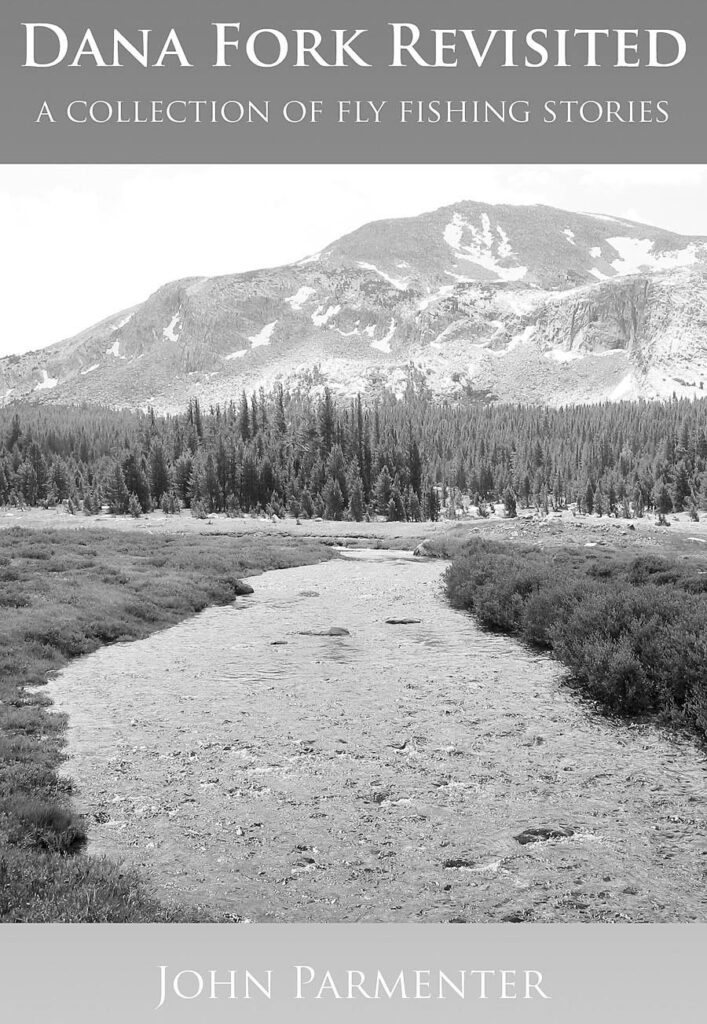
Dana Fork Revisited: A Collection of Fly Fishing Stories
By John Parmenter. Published by The Whitefish Press, 2012; $19.95 softbound.
John Parmenter, a retired SoCal school teacher, has been fly fishing for much of his life and, more recently, writing about his experiences. (Six of the essays collected in this slender volume first appeared in Cal Fly Fisher.) His pieces on California waters incorporate useful angling information, and topics also include building bamboo rods and, intriguingly, inventing the San Juan Worm. An enjoyable read.
Richard Anderson



